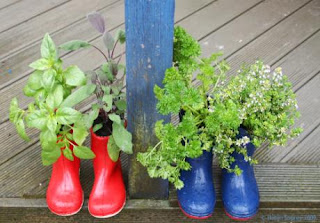Herbs are easy to grow and look fantastic, so why not create your own container
herb garden. Whether it’s a window box, pots along the kitchen window sill or a
few pots by the back door you will soon discover that herbs can be grown
successfully in containers. You will be able to pick your own fresh herbs to
add to your dishes, which far surpasses the flavour that pre-packed dried herbs
offer.
You can use almost any container for growing herbs
as long as it provides drainage, so punch out drainage holes if it has none.
Plastic or glazed pots are best for indoor herbs as they retain the moisture in
the soil better.
Make sure the containers are clean. Place a
layer of gravel at the base of your pots to improve drainage and fill with seed
and cutting potting compost. You can add some horticultural sand to the compost
to improve drainage even further. Fill your containers with either herbs grown
from seed, propagated from cuttings or bought from a garden centre.
Selecting herbs
So which herbs should you grow? It sounds obvious
but if growing herbs for culinary purposes then select the herbs that you will
want to use to flavour your dishes. Alternatively you can select herb varieties
for their decorative foliage or scent.
There are three types of herbs; annuals, biennials
and perennials. Annuals live only for one year and will flower and develop
seeds from which new plants will grow the following year and include basil,
borage, chamomile, chervil, coriander, dill, fennel and summer savory .Some
herbs (caraway and parsley) are biennials; flowering and developing seeds in
their second year. Perennial herbs such as bay, chives, lavender, lemon grass,
lovage, marjoram, mint, oregano, rosemary, sage, tarragon, thyme and winter savoury
last for several years.
The most common herbs that are grown are basil,
chives, coriander, dill, marjoram, mint, parsley, rosemary and sage. However
there are many more varieties to grow. You
may decide to group some herbs together in a single container, but select
complimentary varieties that will not outgrow their positions or compete with
each other. Some woody herbs such as rosemary or lavender can become
thugs to the detriment of surrounding plants. Perennial herbs such as lemon
balm or mint are often grown alone in containers as they need to be controlled
to prevent them from taking over your garden border.
You can sow most herbs from seed in spring from March - April. Alternatively you can propagate herbs by taking cuttings. You can propagate your herbs by taking cuttings of bay, marjoram, mint, rosemary, sage, tarragon and thyme from late summer to early autumn. Herbs such as sweet marjoram, oregano, mint and thyme can be divided in the spring or after flowering in late summer. At the end of the season pot up herbs such as chives, mint, parsley, or tarragon and bring them in to a south facing windowsill for the winter. Gradually acclimatise them to more shady conditions for a few weeks before you bring them inside to avoid shock as conditions inside will be much less bright.
Maintenance
Many herbs originate in the Mediterranean so they like warm and light conditions. However some, such as parsley, basil or chervil, will appreciate a little shade in the hottest part of the day. Water your herbs sparingly, only when the soil is dry. Feed herbs with a general purpose fertiliser weekly during the growing season. You may need to control the pests and treat with a spray insecticide or insecticidal soap weekly.
Photos care of outdoorlivingchicagoland.com, thedailygreen.com, ukhandmade.co.uk, blog.designsquish.com
For related articles click onto:
Feeding plants
Growing Garlic in Containers
Growing herbs
Growing herbs on a windowsill
Growing herbs in pots
Herbaceous borders
How to grow garlic
How to grow lavender
How to build a cold frame
How to grow basil
How to grow coriander
How to grow garlic
How to grow geraniums
How to Grow Ginger
How to grow lavender
How to grow mint
How to grow parsley
How to grow parsley indoors
How to grow parsley
How to grow rosemary
How to grow thyme
How to make compost
How to propagate using division
How to propagate from seed
Plants for free
Preparing a seed bed
Potagers
Watering plants
Growing Garlic in Containers
Growing herbs
Growing herbs on a windowsill
Growing herbs in pots
Herbaceous borders
How to grow garlic
How to grow lavender
How to build a cold frame
How to grow basil
How to grow coriander
How to grow garlic
How to grow geraniums
How to Grow Ginger
How to grow lavender
How to grow mint
How to grow parsley indoors
How to grow parsley
How to grow rosemary
How to grow thyme
How to make compost
How to propagate using division
How to propagate from seed
Plants for free
Preparing a seed bed
Potagers
Watering plants




No comments:
Post a Comment